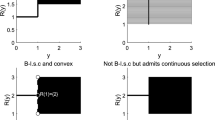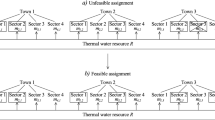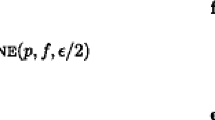Abstract
Usually some of the constraints of a 0-1-Mixed Integer Linear Programming problem correspond to resources and in this paper we suppose that they may be redefined. For the availability of the resources the average shadow price is the maximum price that the decision maker is willing to pay for an additional unit of the package (i.e. a combination) of resources defined by some direction. In this paper we present a generalization of the average shadow price and its relation with bottlenecks including the analysis relative to the coefficients matrix of resource constraints. The generalization presented does not have some limitations of the usual average shadow price. A mathematical programming approach to find the strategy for investment in resources is presented.








Similar content being viewed by others
References
Akgull MA (1984) A note on shadow prices in linear programming. J Oper Res Soc 35:425–431
Alkaly RE, Klevorick AK (1966) A note on the dual prices of integer programs. Econometrica 34:206–214
Aucamp DC, Steinberg DC (1982) The computation of shadow prices in linear programming. J Oper Res Soc 33:557–565
Barahona F, Chudak FA (2005) Near-optimal solutions to large-scale facility location problems. Discrete Optim 2:35–50
Bonyadi MR, Michalewicz Z (2014a) Evolutionary computation for real-world problems. Challenges in computational statistics and data mining. In: Matwin S, Mielnikzuk J (eds) Studies in computational intelligence. Springer, Berlin
Bonyadi MR, Michalewicz Z, Wagner M (2014b) Beyond the edge of feasibility: analysis of bottlenecks. Simulated Evolution and Learning Lecture Notes Computer Science, vol. 8886, pp 431–442
Crema A (1995) Average shadow price in a mixed integer linear programming problem. Eur J Oper Res 85(3):625–635
Freund RM (1985) Postoptimal analysis of a linear program under simultaneous changes in matrix coefficients. Math Program Stud 24:1–13
Gal T (1984) Linear parametric programming—a brief survey. Math Program Stud 21:43–68
Gal T (1986) Shadow prices and sensitivity analysis in linear programming under degeneracy. State Art Surv Oper Res Spectr 8:59–71
Gomory RE, Baumol WJ (1960) Integer programming and prices. Econometrica 28:521–550
Gupte A, Ahmed S, Cheon MS, Dey S (2013) Solving mixed integer bilinear problems using milp formulations. SIAM J Optim 23(2):721–744
Jansen B, Roos C, de Jong JJ, Terlaky T (1997) Sensitivity analysis in linear programming: just be careful!. Eur J Oper Res 101(1):15–28
Kim S, Cho S (1988) A shadow price in integer programming for management decision. Eur J Oper Res 37(3):328–335
Kim S, Cho S (1992) Average shadow prices in mathematical programming. J Optim Theory Appl 74(1):57–74
Martello S, Toth P (1990) Knapsack problems, algorithms and computer implementations. Wiley, New York
Martin DH (1975) On the continuity of the maximum in parametric linear programming. J Optim Theory Appl 17(3/4):205–210
Mukherjee S, Chatterjeeb AK (2006a) The average shadow price for MILPs with integral resource availability and its relationship to the marginal unit shadow price. Eur J Oper Res 169(1):53–64
Mukherjee S, Chatterjeeb AK (2006b) Unified concept of Bottleneck. Indian Institute of Management Ahmedabad-380015, India. W.P. No. 2006-05-01
Puchinger J, Raidl G, Pferschy U (2010) The multidimensional knapsack problem: structure and algorithms. INFORMS J Comput 22(2):250–265
Shapiro JF (1979) Mathematical programming. Wiley, New York
Williams HP (1997) Integer programming revisited. IMA J Math Appl Bus Ind 8:203–213
Yamada T, Takeoka T (2009) An exact algorithm for the fixed-charge multiple knapsack problem. Eur J Oper Res 192:700–705
Zuidwijk RA (2005) Linear parametric sensitivity analysis of the constraint coefficient matrix in linear programs. Erasmus Research Institute of Management, Report Series Research in Management
Author information
Authors and Affiliations
Corresponding author
Appendix
Appendix
Proof of Lemma 1:
(1) Let \(Y(\theta ) = \lbrace \mathbf {y}\in {\lbrace 0,1 \rbrace }^k:\exists \mathbf {x} \, \text{ such } \text{ that } \,\mathbf {(x,y)} \in F(P(\theta )) \rbrace \forall \theta \in [0,1]\).
Because of \(\varOmega \) is a compact set then there exists \(\theta (\mathbf {y})\) such that \(\theta (\mathbf {y}) = \hbox {min} \lbrace \theta : \mathbf {y} \in Y(\theta ),\;\;\theta \in [0,1] \rbrace \) \(\forall \mathbf {y} \in Y(1)\).
If \(Y(0) = Y(1)\) let \(\delta _1 = 1\), otherwise let \(\delta _1 =\hbox {min} \lbrace \theta (\mathbf {y}): \mathbf {y} \notin Y(0) \rbrace \) then \(Y(0) = Y(\theta )\;\forall \theta \in [0,\delta _1)\).
(2) Let \(\mathbf {y} \in Y(0)\). Let \(P(\mathbf {y},\theta )\) be a problem in x defined as follows:
\(P(\mathbf {y},\theta )\) is a Linear Programming (LP) problem. Let \(g_\mathbf {y}: [0,1] \longrightarrow \mathbb {R}\) be a function such that \(g_\mathbf {y}(\theta ) = v(P(\mathbf {y},\theta ))\). Note that \(v(P) = v(P(0)) = \hbox {max} \lbrace g_\mathbf {y}(0): \mathbf {y} \in Y(0) \rbrace \). It has been observed that \(g_\mathbf {y}\) is locally rational and upper semicontinuous (Freund 1985; Gal 1984; Martin 1975; Zuidwijk 2005) . It follows that \(g_\mathbf {y}\) is locally derivable at zero from the right.
Let \(p(\mathbf {y}) = \frac{dg_\mathbf {y}(0)}{d\theta ^+}\). Let \(\epsilon > 0\) then there exists \(\delta (\mathbf {y})\) such that \(\frac{g_\mathbf {y}(\theta ) - g_\mathbf {y}(0)}{\theta } \le p(\mathbf {y}) + \epsilon \;\forall \theta \in (0,\delta (\mathbf {y})) \forall \mathbf {y} \in Y(0)\).
(3) Let \(\delta ^* = \hbox {min} \lbrace \delta _1, \hbox {min} \lbrace \delta (\mathbf {y}):\mathbf {y} \in Y(0) \rbrace \rbrace \). Let \(p^* = \hbox {max} \lbrace p(\mathbf {y}): \mathbf {y} \in Y(0) \rbrace \) and let \(\theta \in (0,\delta ^*)\). We have that:
Therefore \(\frac{f(\theta )}{\theta } \le p^* + \epsilon \) for all \(\theta \in (0,\delta ^*)\). Let \(p^{**} = \frac{f(1)}{\delta ^*}\) then \(\frac{f(\theta )}{\theta } \le p^{**}\) for all \(\theta \in [\delta ^*,1]\) and finally \( \hbox {max} \lbrace \frac{f(\theta )}{\theta }:\theta \in (0,1] \rbrace \le \hbox {max} \lbrace p^{**},p^* + \epsilon \rbrace \) and Q is a bounded set. \(\square \)
Proof of Lemma 4:
Let \(\theta ^*\) be an optimal solution for E(p) then \(f(\theta ) - p\theta \le f(\theta ^*) - p\theta ^*\) for all \(\theta \in [0,1]\). It follows that \(f^+(\theta ) \le f(\theta ^*) + p(\theta - \theta ^*)\) for all \(\theta \in [0,1]\), therefore:
\(\square \)
Proof of Lemma 5:
Let \(f^+\) the concave envelope of f. Let \(l \ge 1\) and let \(C^+(f) = \lbrace (\overline{\theta }_i,q_i): i=1,\ldots ,l\rbrace \) with
-
(i)
\(0=\overline{\theta _1}< \cdots< \overline{\theta _{l-1}} < \overline{\theta _l} =1\),
-
(ii)
\(q=q_1> \cdots> q_{l-1} > q_l = 0\),
-
(iii)
\(f^+ (\theta ) = q_1 \theta \) if \(0 = \overline{\theta _1} \le \theta \le \overline{\theta _2}\) and
-
(iv)
\(f^+ (\theta ) = f^+ (\overline{\theta _{i-1}}) + q_{i-1} (\theta - \overline{\theta _{i-1}})\) if \( \overline{\theta _{i-1}} \le \theta \le \overline{\theta _i}\;\;(i=2,\ldots ,l)\)
If \(0 = q_l \le p_r < q_{l-1}\) then \(v(E(p_r)) = f^+(\overline{\theta _l}) - p_r \overline{\theta _l}\) with \(\overline{\theta _l} = 1\) the unique optimal solution for \(E(p_r)\).
If \(p_r = q_1 = q\) then \(v(E(p_r)) = 0\) and the algorithm stops.
Let us suppose that \(q_i< p_r < q_{i-1}\) for some \(i \le l-1\) then \(v(E(p_r)) = f^+(\overline{\theta _i}) - p_r \overline{\theta _i}\) with \(\overline{\theta _i}\) the unique optimal solution for \(E(p_r)\).
If \(p_r=q_i\) for some \(1< i < l\) then any \(\theta \) in \([\overline{\theta _i},\overline{\theta _{i+1}}]\) is an optimal solution for \(E(p_r)\) and \(v(E(p_r)) > 0\). Let \(\theta _{r+1} \in (\overline{\theta _i},\overline{\theta _{i+1}})\). In this case \(\theta _{r+2} \le \overline{\theta _i}\).
It follows that each piece is visited at most two times. Because of the number of pieces is finite then the g.a.s.p algorithm is finite. \(\square \)
Proof of Lemma 6:
(1) We have that \(0 \le v(E(p_{r+1})) < v(E(p_r))\) for all \(r \ge 0\) and then there exists \(s \ge 0\) such that \(lim_{r \longrightarrow \infty } v(E(p_r)) = s\).
If \(s > 0\) then \(0 < s \le v(E(p_r)) = f(\theta _{r+1}) - p_r \theta _{r+1}\) for all \(r \ge 0\) and then \(p_{r+1} \ge p_r + \frac{s}{\theta _{r+1}} \ge p_r + s\) for all \(r \ge 0\). Hence we have that \(lim_{r \longrightarrow \infty } p_r = \infty \) and then \(lim_{r \longrightarrow \infty } v(E(p_r)) = 0\) and we have a contradiction. Therefore \(s=0\).
(2) We have that \(0 \le p_{r+1} < p_r\) for all \(r \ge 0\) and then there exists \(\hat{p}\) such that \(\hat{p} \le q\), \(p_r \le \hat{p}\) for all \(r \ge 0\) and \(lim_{r \longrightarrow \infty } p_r = \hat{p}\). Let \(\hat{\theta }\) an optimal solution for \(E(\hat{p})\) then \(v(E(\hat{p})) \le v(E(\hat{p})) + (\hat{p} - p_r) \hat{\theta }= f(\hat{\theta }) - p_r \hat{\theta }\le f(\theta _{r+1}) - p_r \theta _{r+1} = (p_{r+1} - p_r) \theta _{r+1} \le (p_{r+1}- p_r)\) for all \(r \ge 0\) and then \(v(E(\hat{p})) = 0\) because of \(lim_{r \longrightarrow \infty } (p_{r+1}-p_r)=0\). Therefore \(q = \hat{p}\). \(\square \)
Rights and permissions
About this article
Cite this article
Crema, A. Generalized average shadow prices and bottlenecks. Math Meth Oper Res 88, 99–124 (2018). https://doi.org/10.1007/s00186-018-0630-8
Received:
Published:
Issue Date:
DOI: https://doi.org/10.1007/s00186-018-0630-8




